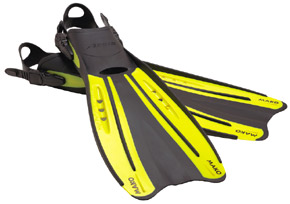|
Scuba Diving Fins
The purpose of scuba diving fins is to simply propel you through the water. That sounds simple enough, than why are there so many styles? There are four basic styles of scuba fins: • Full foot Fins • Open heel fins • Long Blade fins • Force fins
Full foot finsFull foot fins the most efficient. They are light weight and easy to pack. Full foot fins are the most popular among snorkelers. If you need to wear booties on your feet because the water is cold or the sand is hot, then you should consider open heel fins.
Open heel scuba diving finsOpen heel scuba diving fins allow snorkelers or scuba divers to wear booties on their feet. This is good if you have a long hike to the water or across hot sand. Additionally if you need to wear boots for colder water, open heel fins would be advisable.
Long Blade Free Diving finsLong blade free diving fins are very much longer than standard open heel fins. The extra blade length provides burst of speed and power. Free divers prefer the longer blade when under water hunting or competition.
Force FinsForce Fins were designed by Bob Evans, These fins are very efficient and comfortable. Force fins has a vast selection of styles for most types of snorkeling Once you decide on which style of scuba diving fins you are interested in, you need to consider how much bulk or drag you will be exhibiting in the water. Full Scuba gear will require a larger blade verses a snorkeler who will need a smaller blade. With the style and blade size determined, it’s time to start trying on the scuba diving fins. If you are going to be using a bootie, try the fin on with the bootie on! Comfort is the next important consideration. If the scuba diving fins are not comfortable or unyielding, they will not work as intended. There is a lot of math and angle/vector consideration in the engineering of fins. If your kick stroke is modified because they are not comfortable, they will not work as advertised.
The engineering considerations for scuba diving fins are immense. The main design effort centers on how much water or thrust is directly behind the diver in the opposite direction of the intended or desired direction. The paddle fin style is designed to move water up and down at tangents to the blade. The combined sum of all of these angles is 180 degrees behind the diver. These work best in high current areas. Some fin designs have adapted a pivot point system to encourage greater pivot angles to be more efficient in directing water directly behind the diver. This design offers a improvement over the paddle fins design by the elimination of the most upward and downward kick angles. The best design over all is the spilt fin design, when looked at the efficiency of water movement. To make the split fin work even better, consider fins made with soft and high flexible materials. Some of the cheap versions use a stiff thermo plastic material. These fins are stiff and do not work as well. The best known scuba diving fin is Apollo’s Bio fin. These fins are engineered to push back the water directly behind you, making the task much easier. The last design is Force Fins. They are designed to simulate a whale fin. Many people feel these are the best fins on the market. It is my experience that you will 100% love or hate these fins. If you like them, there is no better fin. I prefer the Scuba Pro Split fin or the Apollo Bio-fin. With all of these choices, the task can be daunting. Establish you budget first. If you think you are only going to use fins once or twice, consider renting your gear. Most good fins run around $150 -$250. If this is not within your budget, go all the way down to the $49 range. The fins priced at $60 - $120 do not offer the great of price verses performance.
|
